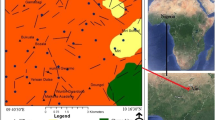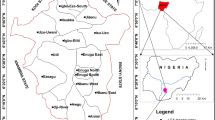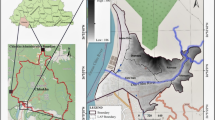Abstract
The poor quality and inconsistent nature of most surface water supply in arid and semi-arid regions of the world has increased the reliance on groundwater resources. However, the susceptibility of groundwater to anthropogenic pollution in most cities and rural communities in Nigeria has become a major source of concern. In this study, the protective capacity of the aquifers in parts of the Bauchi State, Northeastern, Nigeria, from surface contamination was investigated in light of the geoelectrical characteristics of the overburden materials for sustainable management of the resources. This study applied a geographical information system (GIS) technique to secondary geoelectrical parameters (Dar-Zarrouk) derived from 94 vertical electrical soundings (VES) to delineate aquifer vulnerability zones. Five different thematic maps (topsoil longitudinal unit conductance, total overburden longitudinal unit conductance, total transverse unit resistance, coefficient of anisotropy, and total overburden isopach) were developed. Suitable weights were assigned to the thematic maps based on their relative influence on the protection of groundwater systems in the area. Subsequently, the ranks of the subclasses of the themes were reclassified based on their respective suitability before the thematic maps were integrated using ArcGIS 10.3 software to generate the overall aquifer protective capacity map of the study area. To validate the map, water samples were collected from 40 wells and trace elements (e.g., Ni, Cu, Sb, Cr, and As) were analyzed. The study area was categorized into three aquifer vulnerability zones: moderate (32.4%), weak/fair (54.5%), and low/poor (13.1%). Moderate zones with limited portions of fair/weak zones were the predominant zones within the basement setting. This reflects the occurrence of clayey saprolitic units within the basement terrain (< 100 Ωm) occasioned by weathering of weak ferromagnesian minerals. However, the weak and the poor zones predominate the sedimentary setting with the poor zones concentrated in the southwestern zones of the study underlain by the sedimentary rocks. The poor to weak aquifer protective capacity ratings of the sedimentary settings indicate overburden layers devoid of argillaceous materials and conform to porous and permeable sandy sequences with high transmissivity as revealed by the high transverse unit resistance values (> 15,000 Ωm2). Over 60% of the basement settings are characterized by moderate aquifer protective capacity. On the other hand, the sedimentary zones due to weak and poor protective capacity zones are more vulnerable to pollution. The trace elemental analysis shows the predominance of As, Cu, and Sb in the sedimentary zones as compared to the basement setting which corroborates the aquifer protective capacity map produced.











Similar content being viewed by others
References
Abiola O, Enikanselu PA, Oladapo MI (2009) Groundwater potential and aquifer protective capacity of over-burden units in Ado-Ekiti, southwestern Nigeria. Int J Phys Sci 4(3):120–132
Abolude DS, Davis OA, Chia AM (2009) Distribution and concentration of trace elements in Kubani Reservoir in Northern Nigeria. Res J Environ Earth Sci 1(2):9–44
Adeniji AE, Omonona OV, Obiora DN, Chukudebelu JU (2014) Evaluation of soil corrosivity and aquifer protective capacity using geo-electrical investigation in Bwari basement area. Abuja J Earth Syst Sci 123(3):491–502. https://doi.org/10.1007/s12040-014-0416-1
Adepelumi AA, Ako BD, Ajayi TR (2001) Groundwater contamination in the basement complex area of Ile-Ife southwestern Nigeria: A case study using the electrical- resistivity geophysical method. Hydrogeol J 9:611–622. https://doi.org/10.1007/s10040-001-0160-x
Adepelumi AA, Ako BD, Ajayi TR, Afolabi O, Omotoso EJ (2008) Delineation of saltwater intrusion into the freshwater aquifer of Lekki Peninsula, Lagos, Nigeria. Environ Geol 56(5):927–933. https://doi.org/10.1007/s00254-008-1194-3
Akaha CT, Promise AA (2009) Hydraulic properties from pumping tests data of aquifers in Azare area, North Eastern Nigeria. J Appl Sci Environ Manag 12(4):67–72
Akanbi OA (2018) Hydrogeological characterisation and prospect of basement Aquifers of Ibarapa region, southwestern Nigeria. Appl Water Sci 8:89. https://doi.org/10.1007/s13201-018-0731-9
Akujieze CN, Coker SJL, Oteze GE (2003) Groundwater in Nigeria-a millennium experience, distribution, practice, problems and solutions. Hydrogeol J 11:259–274
APHA (American Public Health Association) (2017) Standard methods for the examination of water and wastewater, 23rd edn. American Water Works Association, Water Environment Federation, Washington
Atakpo EA, Ayolabi EA (2009) Elevation of aquifer vulnerability and protective capacity in some oil producing communities of western Niger Delta. Environmentalist 29(3):310–317. https://doi.org/10.1007/s10669-008-9191-3
Aviedo E, Elijah A, Ayolabi A (2009) Evaluation of aquifer vulnerability and the protective capacity in some oil producing communities of western Niger Delta. Environmentalist 29:310–317. https://doi.org/10.1007/s10669-008-9191-3
Ayolabi EA (2005) Geoelectric evaluation of Olushosun landfill site Southwest Nigeria and its implication on groundwater. J Geol Soc India 66(3):318–322
Batayneh AT (2013) The estimation and significance of Dar- Zarrouk parameters in the exploration of quality affecting the Gulf of Aqaba coastal aquifer systems. J Coast Conserv 17(3):623–635. https://doi.org/10.1007/s11852-013-0261-4
Benkhelil J (1989) The origin and evolution of the Cretaceous Benue Trough (Nigeria). J Afr Earth Sci 8(2–4):251–282. https://doi.org/10.1016/S0899-5362(89)80028-4
Benson AK, Payne KL, Stubben MA (1997) Mapping groundwater contamination using dc resistivity and VLF geophysical methods: a case study. Geophysics 62(1):80–86. https://doi.org/10.1190/1.1444148
Braga ACO, Malagutti Filho W, Dourado JC (2006) Resistivity (DC) method applied to aquifer protection studies. Braz J Geophys 24(4):573–581
Calow RC, MacDonalds AM, Nicol AL, Robins NS (2010) Groundwater security and drought in Africa: linking availability, accesses, and demand. Groundwater 48(2):246–256
D’Alessio M, Ray C (2016) Pharmaceuticals and groundwater resources. Emerging issues in groundwater resources. Springer, Cham, pp 101–144
Dike EFC (1993) Stratigraphy and structure of the Kerri-Keri Basin, NE Nigeria. J Min Geol 29(2):77–93
Draskovits P, Mayar B, Pattantyus AM (1995) Geophysical methods in groundwater prospecting and environmental protection. Fisica de la Tierra 7:53–86
Du Preez JW, Barber W (1965) The distribution and chemical quality of groundwater in Northern Nigeria. Geol Surv Nig Bull 36, 93
Eastman RJ (2001) Guide to GIS and image processing. Clark University, USA, p 44
Edet AE, Nganje TN, Ukpong AJ, Ekwere AS (2011) Groundwater chemistry and quality of Nigeria: a status review. Afr J Environ Sci Technol 5(13):1152–1169
Ehirim CN, Nwankwo CN (2010) Evaluation of aquifer characteristics and groundwater quality using geoelectric method in Choba. P H Arch Appl Sci Res 2(2):396–403
FAO (2017) The future of food and agriculture. Trends and challenges. Food and Agriculture Organization of the United Nations (FAO), Rome
Freeze RA, Cherry JA (1979) Groundwater. Prentice-Hall, New Jersey
Guelala R, Ignoble MH, Amri F (2009) New elements on the structure of the Ghardimaou superficial aquifer (Tunisia): electrical geophysics results. Hydrol Sci J 54(5):974–983
Hasan M, Shang Y, Akhter G, Khan M (2017) Geophysical investigation of fresh-saline water interface: a case study from south Punjab. Pak Groundw 55(6):841–856. https://doi.org/10.1111/gwat.12527
Henriet JP (1976) Direct applications of the Dar Zarrouk parameters in ground water surveys. Geophys Prospect 24(2):344–353. https://doi.org/10.1111/j.1365-2478.1976.tb00931.x
Isife FA, Obasi RA (2012) Electrical anisotropy of crystalline basement/sediment rock around Ifon, south- western Nigeria: Implications in geologic mapping and groundwater investigation. ARPN J Eng Appl Sci 7:634–640
JICA (2014) The project for review and update of Nigeria national water resources master plan; Vol.2 Japan International Cooperation Agency: Yachiyo Engineering Co., Ltd.: CTI Engineering International Co., Ltd.: Sanyu Consultants Inc. JICA, Tokyo
Keller GV, Frischknecht FC (1966) Electrical methods in geophysical prospecting. Pergamon Press, Oxford
Kelly WE, Reiter PF (1984) Influence of anisotropy on relation between electrical and hydraulic properties. J Hydrol 74(3–4):311–321. https://doi.org/10.1016/0022-1694(84)90021-0
Lawal A, Tijani MN, D’Alessio M (2020) Geoelectrical characterisation of aquifers in Bauchi-Alkaleri-Kirfi geological transition zones, Northeast Nigeria. Environ Earth Sci 79:224. https://doi.org/10.1007/s12665-020-08978-5
Leung CM, Jiao JJ (2006) Heavy metal and trace element distributions in groundwater in natural slopes and highly urbanized spaces in Mid-Levels area. Hong Kong Water Res 40(4):753–767
Michot D, Benderitter Y, Dorigny A, Nicoullaud B, King D, Tabbagh A (2003) Spatial and temporal monitoring of soil water content with an irrigated corn crop cover using surface electrical resistivity tomography. Water Resour Res 39(5):1138. https://doi.org/10.1029/2002WR001581
Mogaji KA, Adiat KAN, Oladapo MI (2007) Geo-electric investigation of the Dape Phase 111 Housing Estate FCT Abuja Northcentral Nigeria. J Earth Sci 1(2):76–84
Mohammed MZ, Olorunfemi MO, Idonigie AI (2012) Geoelectric sounding for evaluating soil corrosivity and the vulnerability of porous media aquifers in parts of the Chad basin fadama floodplain, northeastern Nigeria. J Sustain Dev 5(7):111–126
Murali S, Patangay NS (1998) Principles of application of ground-water geophysics. Association of Geophysicists, Hyderabad, p 37
Naudet V, Revil A, Rizzo E, Bottero JY, Begassat P (2004) Groundwater redox conditions and conductivity in a contaminant plume from geoelectrical investigations. Hydrol Earth Sci 8(1):8–22
Ndatuwong LG, Yadav GS (2015) Application of geo-electrical data to evaluate groundwater potential zone and assessment of overburden protective capacity in part of Sonebhadra district, Uttar Pradesh. Environ Earth Sci 73(7):3655–3664. https://doi.org/10.1007/s12665-014-3649-z
Niwas S, Singhal DC (1981) Estimation of aquifer transmissivity from Dar-Zarrouk parameters in porous media. J Hydrol 50:393–399. https://doi.org/10.1016/0022-1694(81)90082-2
Nwankwo C, Nwosu L, Emujakporue G (2011) Determination of Dar Zarouk parameters for the assessment of groundwater resources potential: case study of Imo State, south eastern Nigeria. J Econ Sustain Dev 2:57–71
Obaje NG (2009) Geology and mineral resources of Nigeria. Lecture notes in earth sciences. Springer, Berlin. https://doi.org/10.1007/978-3-540-92685-6
Obiora DN, Ajala EA, Ibuot JC (2014) Evaluation of aquifer protective capacity of overburden unit and soil corrosivity in Makurdi, Benue state, Nigeria, using electrical resistivity method. J Earth Syst Sci 124(1):125–135. https://doi.org/10.1007/s12040-014-0522-0
Ocheri MI, Ode OO (2012) Water quality from hand dug wells in Oju town, Benue State, Nigeria. Niger J Hydrol Sci 1:57–66
Olayinka AI, Akpan EJ, Magbagbeola OA (1997) Geoelectric sounding for estimating aquifer potential in the crystalline basement area around Shaki, SouthWest Nigeria. Water Resour J Niger Assoc Hydrogeol 8(1–2):71–81
Oladapo MI, Mohammed MZ, Adeoye OO, Adetola BA (2004) Geoelectrical investigation of the Ondo State Housing Corporation Estate Ijapo Akure, southwestern Nigeria. J Min Geol 40(1)
Olorunfemi MO, Ojo JS, Akintunde MO (1999) Hydrogeophysical evaluation of the groundwater potentials of the Akure metropolis, southwestern Nigeria. J Min Geol 35(2):207–228
Omosuyi GO (2010) Geoelectric assessment of groundwater prospect and vulnerability of overburden aquifer at Idanre, southwestern Nigeria. Ozean J Appl Sci 3(1):19–28
Oyawoye MO (1964) The geology of the Nigerian basement complex. A survey of our present knowledge of them. J Niger Min Geol Metall Soc 1(2):87–102
Palacky GJ (1988) Resistivity characteristics of geological targets. Electromagn Methods Appl Geophys 1:53–129
Rao PJ, Rao BS, Rao MJ, Harikrishna P (2003) Geo-electrical data analysis to demarcate groundwater pockets and recharge zones in Champavathi River Basin, Vizianagaram District, Andhrs Pradesh. J Ind Geophys Union 7(2):105–113
Rhoades JD, Chanduvi F, Lesch S (1999) Soil salinity assessment: methods and interpretation of electrical conductivity measurements. FAO Irrigation and Drainage, Food and Agriculture Organization of the United Nations, No. 57. Rome, Italy.
Salem HS (1999) Determination of fluid transmissivity and electric transverse resistance for shallow aquifers and deep reservoirs from surface and well-logs electric measurements. Hydrol Earth Syst Sci Discuss Eur Geosci Union 3(3):421–427
Setianto A, Triandini T (2013) Comparison of kriging and inverse distance weighted (IDW) interpolation methods in lineament extraction and analysis. J Appl Geol 5(1):21–29. https://doi.org/10.22146/jag.7204she
Sharma PK, Mayank M, Ojha CSP, Shukla SK (2020) A review on groundwater contaminant transport and remediation. ISH J Hydraul Eng 261:112–121
Shemang EM, Jiba KT (2005) Assessment of the hydrogeologic properties of the basement aquifers of western part of Bauchi. Nigeria Global J Geol Sci 3(1):39–44. https://doi.org/10.4314/gjgs.v3i1.18709
Singh KP (2005) Nonlinear estimation of aquifer parameters from surficial resistivity measurements. Hydrol Earth Syst Sci Discuss 2(3):917–938
Soupios PM, Kouli M, Vallianatos F, Vafidis A, Stavroulakis G (2007) Estimation of aquifer hydraulic parameters from surficial geophysical methods: a case study of Keritis Basin in Chania (Crete–Greece). J Hydrol 338(1–2):122–131. https://doi.org/10.1016/j.jhydrol.2007.02.028
Telford WM, Sheriff RF (1984) Applied geophysics. Cambridge University Press, Cambridge
Todd DK (1980) Groundwater hydrology, 2nd edn. Wiley, New York, p 552
Todd DK, Mays LW (2005) Groundwater Hydrology. John Willey Sons Incorporated, New York, p 636
Utom AU, Odoh BI, Okoro AU (2012) Estimation of aquifer transmissivity using Dar Zarrouk parameters derived from surface resistivity measurements: a case history from parts of Enugu Town (Nigeria). J Water Resour Prot 4:993–1000. https://doi.org/10.4236/jwarp.2012.412115
WHO (2006) Guidelines for drinking-water quality, 2nd edn. World Health Organization, Geneva
Zhdanov M, Keller G (1994) The geoelectrical methods in geophysical exploration. In: Zhdanov M, Wannamaker PE (eds) Methods in geochemistry and geophysics. Elsevier, Amsterdam, p 408
Zohdy AAR (1989) A new method for automatic interpretation of Schlumberger and Wenner sounding curves. Geophysics 54:245–253
Zohdy AAR, Eaton GP, Mabey DR (1974) Application of surface geophysics to groundwater investigations. Techniques of water resources investigations. US Geological Survey, Washington, p 116
Author information
Authors and Affiliations
Corresponding author
Additional information
Publisher's Note
Springer Nature remains neutral with regard to jurisdictional claims in published maps and institutional affiliations.
Supplementary Information
Below is the link to the electronic supplementary material.
Rights and permissions
About this article
Cite this article
Lawal, A., Tijani, M.N., D’Alessio, M. et al. Application of geographical information system to geoelectrical data for evaluation of the vulnerability of aquifers in parts of Bauchi, Northeastern Nigeria. Environ Earth Sci 80, 16 (2021). https://doi.org/10.1007/s12665-020-09308-5
Received:
Accepted:
Published:
DOI: https://doi.org/10.1007/s12665-020-09308-5




